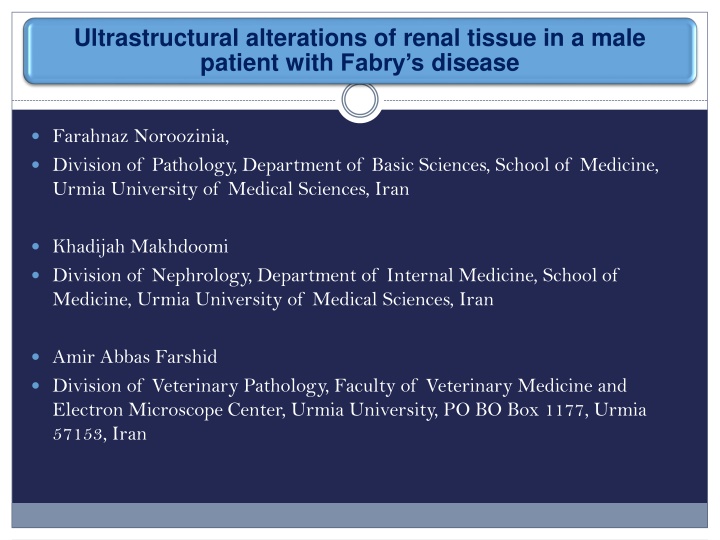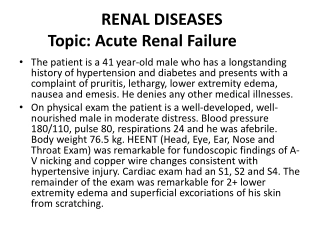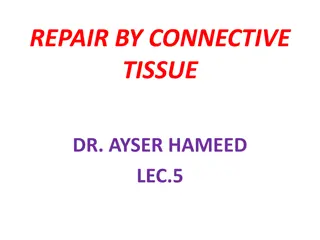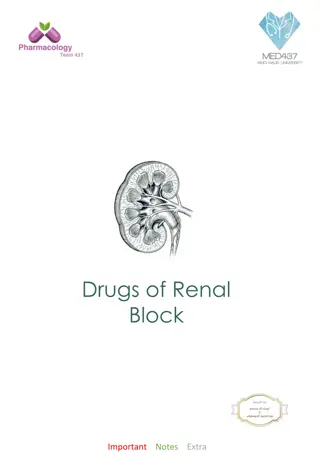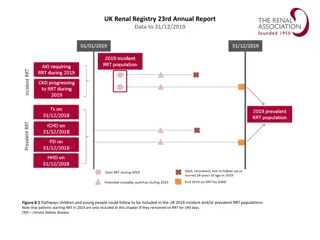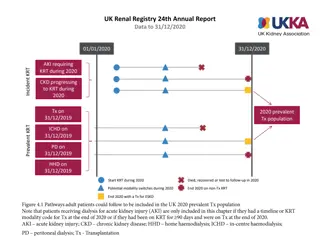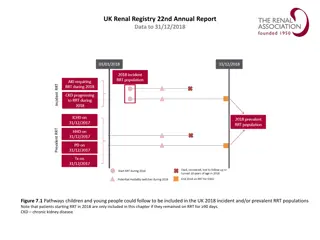Ultrastructural Alterations of Renal Tissue in a Male Patient with Fabry's Disease
Fabry's disease is a rare X-linked lipid storage disorder characterized by deficient lysosomal alpha-galactosidase A activity. This condition primarily affects males, leading to chronic kidney disease and progression to end-stage renal disease. Kidney involvement is a critical aspect, and high doses of agalsidase have shown some promise in treatment. Other common manifestations include skin lesions, cornea verticillata, and peripheral nerve damage. Understanding the ultrastructural alterations in renal tissue is crucial for the diagnosis and management of Fabry's disease.
Download Presentation

Please find below an Image/Link to download the presentation.
The content on the website is provided AS IS for your information and personal use only. It may not be sold, licensed, or shared on other websites without obtaining consent from the author.If you encounter any issues during the download, it is possible that the publisher has removed the file from their server.
You are allowed to download the files provided on this website for personal or commercial use, subject to the condition that they are used lawfully. All files are the property of their respective owners.
The content on the website is provided AS IS for your information and personal use only. It may not be sold, licensed, or shared on other websites without obtaining consent from the author.
E N D
Presentation Transcript
Ultrastructural alterations of renal tissue in a male patient with Fabry s disease Farahnaz Noroozinia, Division of Pathology, Department of Basic Sciences, School of Medicine, Urmia University of Medical Sciences, Iran Khadijah Makhdoomi Division of Nephrology, Department of Internal Medicine, School of Medicine, Urmia University of Medical Sciences, Iran Amir Abbas Farshid Division of Veterinary Pathology, Faculty of Veterinary Medicine and Electron Microscope Center, Urmia University, PO BO Box 1177, Urmia 57153, Iran
Introduction Fabry s disease is a rare X-linked lipid storage disorder due to a deficient lysosomal alpha galactosidase A activity. First discovered by Johannes Fabry, German Dermatologist (1860-1930) The incidence of the disease has been estimated to range from one per 40,000 to one per 117,000 male live births.
The gene for this disorder is on the X-chromosome, the mother needs to be a carrier to produce an affected child (Kes & Basic-Jukic,2005). The mean survival is 40-50 years for males and 70 years for female carriers, with death resulting from cardiac, renal, or cerebrovascular complications (Desnick et al.,2005). Angiokeratomas are common skin lesions which appear in adulthood and are considered as a significant diagnostic value (Luna et al.,2016).
Cornea verticillata consist of bilateral whorl-like opacities located in superficial corneal layers. Was noted in 94.1% hemizygotes and 71.9% heterozygotes patients and considered as an ophthalmological indicator of this disease (Nguyen etal., 2005). Acroparesthesia due to peripheral nerve fibers damage is seen.
Kidney involevment is of much importance. Males classically develop chronic kidney disease and progress to end-stage renal disease before their fifth decade. Globotriaosylsphingosine was identified as a bioactive molecule accumulating in Fabry s disease, which could modulate the release of secondary mediators of injury in podocytes (Sanchez-Nino et al., 2011).
High doses of agalsidase showed to have effects on the clearance of inclusion bodies in epithelial cells of distal tubules as well as podocytes (Tondel et al.,2013). Renal pathological and functional impairment is more evident in hemizygous males than heterozygous females (Lyon,1961). Studies revealed greater podocyte vacuolization in male patients than in female ones (Fogo et al.,2010).
Progressive intracellular deposition of glycosphingolipid which ultimately leads to end-stage renal failure (Sessa et al., 2003; Miura et al.,1983; Reyes et al., 1991). By light microscopy, distinctive Foamy cytoplasmic alterations were observed in renal glomerular, tubular, vascular, and interstitial cells (Burkholder et al., 1980; Idoate et al., 1992; Matsubara et al.,1990). Immunohistochemical localization of glycosphingolipid was also documented (Chatterjee et al., 1984). Other methods, failed to reveal small amounts of stored glycolipid.
Increased podocytouria in Fabry disease, even when proteinurea is absent has been documented (Fall et al., 2016). Maltese cross particles, anti-CD77 antibody binding within vacuolated urinary epithelial cells were detected in Fabry disease (Selvarajah et al., 2011).
Large number of electron dense deposits in the renal tubules, reported, these deposits in all kinds of renal cells showed characteristic onion skin or zebra appearance (Burkholder et al., 1980). Electron microscopic examination of kidney biopsy specimen is important for investigation of storage diseases. Kidney biopsy is of importance in evaluation of Fabry nephropathy (Fogo et al.,2010).
Case report A 19 year old male patient with complaint of: Acroparesthesia, Maculopapular skin lesions Cornea verticillata
Summary of Investigations Investigations Skin biopsy Results Angiokeratoma corporis diffusum EMG/NCV Sonography normal Abdomen : normal Pelvis: normal Brain : normal CT scan Orbit: normal normal normal Cornea verticillata Hematuria Echocardiography Spirometery Ophthalmoscopy Urine analysis
Methods Kidney Biopsy was done Renal tissues fixed in 3% glutraldehyde, post fixed in 1% osmium tetroxide Processed routinely and embedded in spurr resin Ultrathin sections of 60-70 nm were cut Stained with uranyl acetate and lead citrate Examined under TEM (Philips CM 100) at 75KV and electron micrographs were taken.
Results The ultrastructural changes were mainly intracytoplasmic inclusion bodies in the renal cells, they were dense osmophilic with concentric lamellation of clear and dark layers, showing onion skin , zebra appearance and sometimes fingerprint like myelin figures.
These electron dense deposits were more in the podocytes , they were also seen in the mesangial cells , and were found to be less in the tubular epithelial cells. Podocytes were most affected in these structures. In some places foot processes were found to be fused. Cross-sections of collagen fibers were also evident in different parts, indicating fibrosis.
Electron micrograph of intracytoplasmic osmophilic inclusion body(Arrow), showing fingerprint-like myelin figures (Original magnification X 13500).
Dense osmophilic inclusion bodies(I) packed in the cytoplasm of a podocyte, capillary lumen(C) is seen (original magnification X 1850).
Electron micrograph of a podocyte(P) with osmophilic inclusion bodies(I) in its cytoplasm which are typical onion skin or zebra appearance, basement membrane(BM) and capillary lumen(C) are also seen (Original magnification X 7400).
Mesangial cell(M) with dense osmophilic inclusion bodies(I) in its cytoplasm (Original magnification X 3400).
Discussion Intra-cytoplasmic accumulation of glycosphingolipid in the renal cells was clearly demonstrated, they were dense osmophilic concentric lamellar structures that would lead to kidney failure. Myelinosomes in great numbers were found in certain inborn errors of metabolism, these bodies have been given various names such as lipid cytosomes, multimembranous bodies, lamellar bodies, membranous cytoplasmic and zebra bodies.
Myelinosomes containing stacked membranes and membranous whorls have been reported in kidney epithelial cells. Both the types of zebra bodies and whorl types were seen, which they were of zebra body types predominantly. In this case we observed most of these bodies in the podocytes and mesangial cells respectively and very minute in the tubular epithelium in contrast to the other reports in which large amounts of electron dense material were seen in the renal tubules (Suzuki et al., 1999).
This could be the reason in which we could not detect vacuolated epithelial cast in the urine analysis. Globotriaosyloceramide accumulation was associated with increase in autophagosomes. Deregulated autophagy pathways, opened a new horizon on pathogenesis of glomerular injury in Fabry disease (Liebau et al., 2013).
Electron-microscopy is a far superior and easier way to diagnose these bodies than any other technique, however, light microscopy in which cytoplasmic changes in renal cells could be due to other lipid material could not be differentiated from glycosphingolipid (Burkholder et al., 1980; Idoate et al., 1992; Matsubara et al.,1990). When the amount of glycosphingolipid is minute, even histochemistry will not be of diagnostic value (Voglino et al., 1988).
Conclusion The ulta-structure of the kidney clearly showed the intra-cytoplasmic glycosphingolipid accumulation in renal cells, which will lead to progressive decline in renal function. The final diagnosis of Fabry s disease was confirmed. In the present case-study, electron microscopy proved to be a valuable diagnostic aid.
